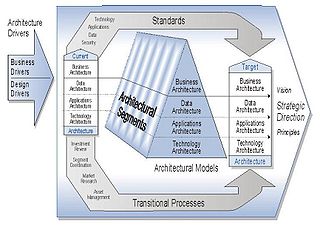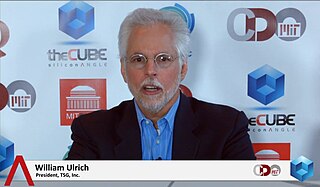Model-driven architecture (MDA) is a software design approach for the development of software systems. It provides a set of guidelines for the structuring of specifications, which are expressed as models. Model Driven Architecture is a kind of domain engineering, and supports model-driven engineering of software systems. It was launched by the Object Management Group (OMG) in 2001.
Information technology (IT)governance is a subset discipline of corporate governance, focused on information technology (IT) and its performance and risk management. The interest in IT governance is due to the ongoing need within organizations to focus value creation efforts on an organization's strategic objectives and to better manage the performance of those responsible for creating this value in the best interest of all stakeholders. It has evolved from The Principles of Scientific Management, Total Quality Management and ISO 9001 Quality Management System.

Business process modeling (BPM) is the action of capturing and representing processes of an enterprise, so that the current business processes may be analyzed, applied securely and consistently, improved, and automated.
Enterprise architecture (EA) is a business function concerned with the structures and behaviours of a business, especially business roles and processes that create and use business data. The international definition according to the Federation of Enterprise Architecture Professional Organizations is "a well-defined practice for conducting enterprise analysis, design, planning, and implementation, using a comprehensive approach at all times, for the successful development and execution of strategy. Enterprise architecture applies architecture principles and practices to guide organizations through the business, information, process, and technology changes necessary to execute their strategies. These practices utilize the various aspects of an enterprise to identify, motivate, and achieve these changes."

The Open Group Architecture Framework (TOGAF) is the most used framework for enterprise architecture as of 2020 that provides an approach for designing, planning, implementing, and governing an enterprise information technology architecture. TOGAF is a high-level approach to design. It is typically modeled at four levels: Business, Application, Data, and Technology. It relies heavily on modularization, standardization, and already existing, proven technologies and products.
A federal enterprise architecture framework (FEAF) is the U.S. reference enterprise architecture of a federal government. It provides a common approach for the integration of strategic, business and technology management as part of organization design and performance improvement.
Technology strategy is the overall plan which consists of objectives, principles and tactics relating to use of technologies within a particular organization. Such strategies primarily focus on the technologies themselves and in some cases the people who directly manage those technologies. The strategy can be implied from the organization's behaviors towards technology decisions, and may be written down in a document. The strategy includes the formal vision that guides the acquisition, allocation, and management of IT resources so it can help fulfill the organizational objectives.

An enterprise architecture framework defines how to create and use an enterprise architecture. An architecture framework provides principles and practices for creating and using the architecture description of a system. It structures architects' thinking by dividing the architecture description into domains, layers, or views, and offers models – typically matrices and diagrams – for documenting each view. This allows for making systemic design decisions on all the components of the system and making long-term decisions around new design requirements, sustainability, and support.

Enterprise modelling is the abstract representation, description and definition of the structure, processes, information and resources of an identifiable business, government body, or other large organization.

An architecture domain in enterprise architecture is a broad view of an enterprise or system. It is a partial representation of a whole system that addresses several concerns of several stakeholders. It is a description that hides other views or facets of the system described. Business, data, application and technology architectures are recognized as the core domains in the most of proposed concepts concerned with the definition of enterprise architecture.

Technical Architecture Framework for Information Management (TAFIM) was a 1990s reference model for enterprise architecture by and for the United States Department of Defense (DoD).
Enterprise interoperability is the ability of an enterprise—a company or other large organization—to functionally link activities, such as product design, supply chains, manufacturing, in an efficient and competitive way.
Enterprise data planning is the starting point for enterprise wide change. It states the destination and describes how you will get there. It defines benefits, costs and potential risks. It provides measures to be used along the way to judge progress and adjust the journey according to changing circumstances.
Capability management is the approach to the management of an organization, typically a business organization or firm, based on the "theory of the firm" as a collection of capabilities that may be exercised to earn revenues in the marketplace and compete with other firms in the industry. Capability management seeks to manage the stock of capabilities within the firm to ensure its position in the industry and its ongoing profitability and survival.
Jaap Schekkerman is a Dutch computer scientist and founder of the Institute For Enterprise Architecture Developments (IFEAD) in the Netherlands. He is particularly known for his 2003 book How to Survive in the Jungle of Enterprise Architecture in which he compared 14 Enterprise Architecture Frameworks.

William M. Ulrich is an American business architecture consultant, consultant at Cutter Consortium, director and lecturer, known for development of 'The Systems Redevelopment Methodology' (TSRM) in the 1990s, on legacy systems in the 2000s and more recently on his work on business architecture.
Gerrit Versteeg is a Dutch enterprise architect and management consultant, known for his work in defining the field of business architecture.
The history of business architecture has its origins in the 1980s. In the next decades business architecture has developed into a discipline of "cross-organizational design of the business as a whole" closely related to enterprise architecture. The concept of business architecture has been proposed as a blueprint of the enterprise, as a business strategy, and also as the representation of a business design.
The Business Architecture Special Interest Group (BASIG) is a working group on business architecture of the Object Management Group (OMG), known for their contribution to the history of business architecture. This working group was founded in 2007 as the Business Architecture Working Group (BAWG).







